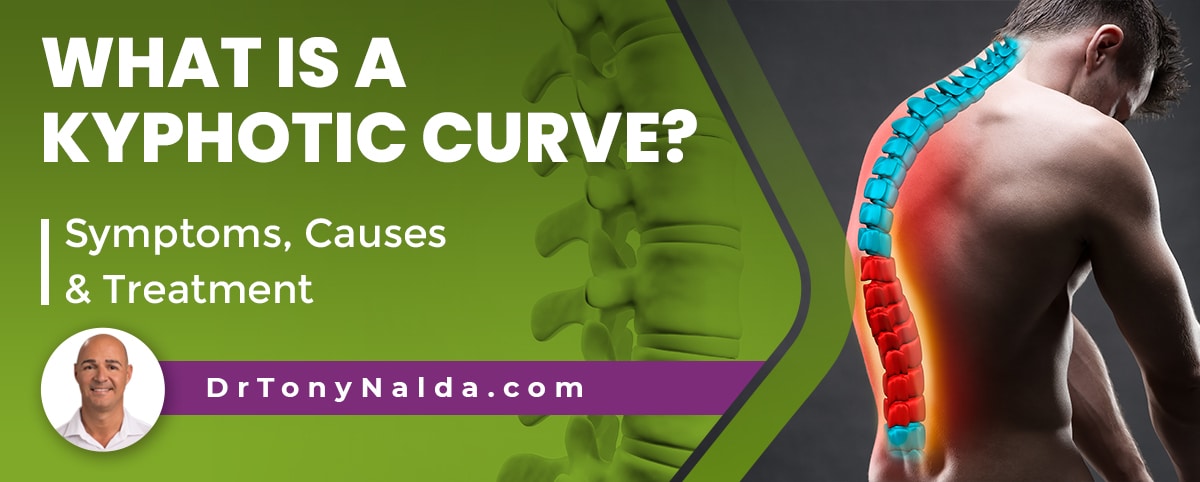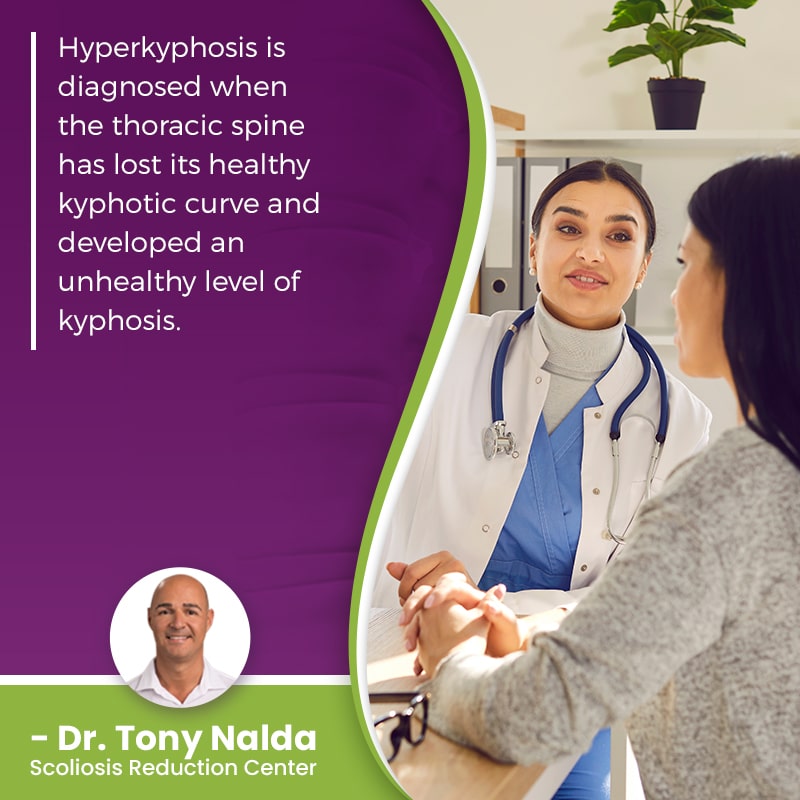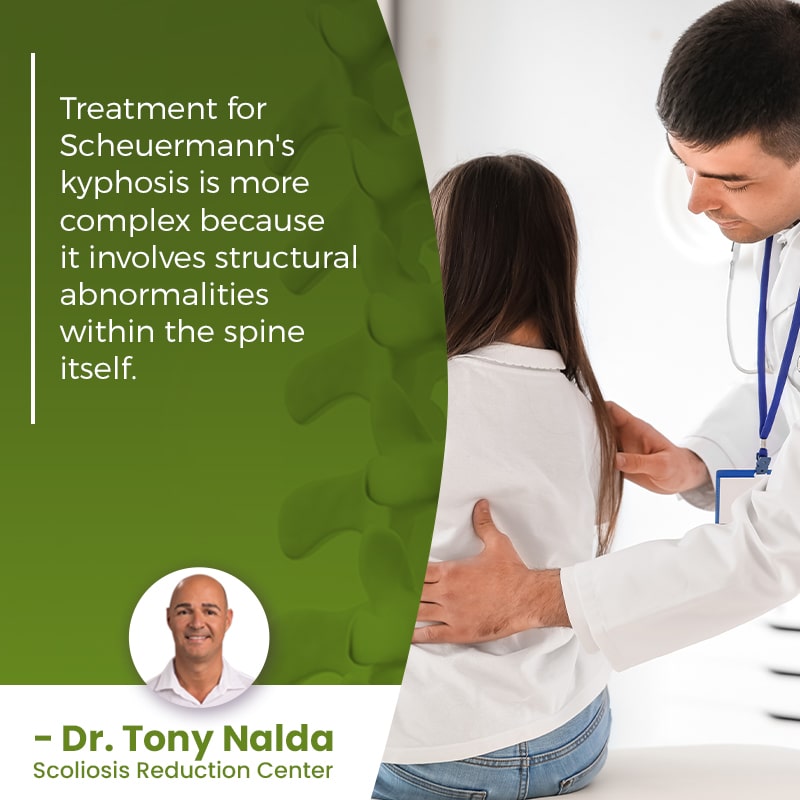What Is A Kyphotic Curve? Symptoms, Causes & Treatment

There is a natural range of spinal curvature sizes, but if a curve falls beyond a normal and healthy range, problems can occur. When the spine's natural and healthy curves are in place, the spine is aligned as it should be and can function optimally; if the spine loses one or more of its healthy curves, the biomechanics of the entire spine are disrupted.
The spine is naturally curved, but those curves can become unnatural and unhealthy if one becomes under- or over-pronounced. A kyphotic curve is a type of spinal curve that bends backwards, away from the body's center, and is found in the thoracic spine.
As the spine's healthy curves are necessary for maintaining spinal health and function, let's discuss the difference between health and unhealthy spinal curves.
Table of Contents
Curvatures of the Spine: Health vs Unhealthy
The spine is naturally curved at each of its main sections, and these curves make the spine stronger, more flexible, and facilitate its ability to evenly distribute and absorb stress from impact, so if one or more of the healthy curves are lost, one or all of those factors can be affected.
The spine has three main sections, each with its own characteristic curvature type: the cervical spine (neck), thoracic spine (middle/upper back), and the lumbar spine (lower back).
As the spine helps to establish the body's center of gravity, unnatural spinal curves can cause a shift in a person's center of gravity that commonly disrupts balance, coordination, and gait.
There are two main types of spinal curves, known as lordosis and kyphosis.
Lordosis and Kyphosis
Lordosis is a type of spinal curve that bends inwards, towards the body's center, and the spine's lordotic curves can be found in the cervical and lumbar spinal sections; kyphosis is a spinal curve type that bends backwards, away from the body's center, and can be found in the thoracic spine.
As the spine is one long structure, the health of each section and its curve is dependent on the health of the other spinal sections.
The degree of lordosis and kyphosis can vary from one person to the next, but as long as they fall within a healthy range, the curves are protected; when a person's lordosis or kyphosis falls beyond a normal range, the curve becomes problematic.
If a person's kyphotic curve becomes exaggerated and over-pronounced, this is diagnosed as hyperkyphosis, but can also be referred to simply as thoracic kyphosis.
What is Hyperkyphosis?
 Hyperkyphosis is diagnosed when the thoracic spine has lost its healthy kyphotic curve and developed an unhealthy level of kyphosis.
Hyperkyphosis is diagnosed when the thoracic spine has lost its healthy kyphotic curve and developed an unhealthy level of kyphosis.
A normal range of thoracic kyphosis is between 20 and 45 degrees; hyperkyphosis is commonly diagnosed at 45+ degrees.
The thoracic spine includes the middle and upper back, and excessive kyphosis is known to cause a noticeable arch as the upper back and shoulders become noticeable rounded forward; this is commonly referred to as roundback.
Some additional symptoms of hyperkyphosis can include:
- Back pain
- Muscle pain
- Spinal rigidity
- Tight hamstrings (weight isn't evenly distributed over the hips and legs)
- Fatigue (due to trying to maintain balance and counteract an uneconomical gait)
- Difficulty standing up straight, particularly for long periods of time
- Cardiac and respiratory issues (associated with severe kyphosis)
An unnatural kyphotic curve causing back pain is more common in adults for whom the condition is compressive; in young patients whose spines are still growing, the constant lengthening motion of a growing spine counteracts the compressive force of the curvature.
The majority of condition-related pain is caused by compression of the spine and its surrounding muscles and nerves.
In order to effectively treat hyperkyphosis, its underlying cause has to be determined and this varies with the different condition types.
What Causes Hyperkyphosis?
There are different types of kyphosis that can develop, each with its own treatment needs and characteristics.
The most common types of hyperkyphosis are postural kyphosis, Scheuermann's kyphosis, and congenital kyphosis.
Postural kyphosis is the most common, and as a non-structural condition, it's the simplest to treat.
When a spinal condition is structural, it involves a structural abnormality within the spine itself, so treatment needs to impact it on a structural level.
With postural kyphosis, the condition is caused by chronic poor posture that, over time, affects the position of the spine; because it's postural, a change in position can alter the nature and size of the kyphotic curve.
Scheuermann's kyphosis, however, is structural, so is more complex to treat because no change in position can alter the nature of the unhealthy kyphotic curvature of the spine.
If the vertebrae of the spine are misshapen in some way, this can cause Scheuermann's kyphosis; in a healthy spine, its vertebrae are rectangular in shape, allowing them to be stacked on top of one another in a healthy and straight alignment, but if one or more of the thoracic vertebrae are triangular in shape, this can cause the vertebrae to wedge forward and develop excessive kyphosis.
Scheuermann's curves tend to be rigid and stiff, and the condition is progressive, meaning it has it in its nature to get worse over time.
Congenital kyphosis is also structural, and it's caused by spinal malformations that occur as the spine develops in utero, so babies are born with it; this can involve vertebrae not forming properly and/or multiple vertebral bodies becoming fused together into one solid bone, rather than forming into separate and distinct vertebral bodies.
Regardless of the type of kyphosis, it can range in severity from mild kyphosis to moderate and severe kyphosis.
So once the type of kyphosis is confirmed, its underlying cause is known, and treatment plans can be customized accordingly.
Hyperkyphosis Treatment Options
Through a combined physical examination and X-ray results, a number of spinal conditions are diagnosed, hyperkyphosis included.
Postural kyphosis, because it's non-structural, is the simplest to treat, and this is often achieved through a combination of physical therapy and condition-specific exercises and stretches.
Physical therapy/exercises can help increase the strength of the core muscles so the spine's surrounding muscles can optimally support it, correct posture, and certain exercises/stretches are also known to stimulate certain areas of the brain from enhanced brain body communication that can result in better body positioning.
 Treatment for Scheuermann's kyphosis is more complex because it involves structural abnormalities within the spine itself.
Treatment for Scheuermann's kyphosis is more complex because it involves structural abnormalities within the spine itself.
As a structural condition, it has to, first and foremost, be impacted on a structural level, and this is worked towards through condition-specific chiropractic care that involves a series of techniques and manual adjustments that can adjust the position of the curve's most-tilted vertebrae back into alignment with the rest of the spine.
Once I see structural results as the excessive kyphosis is reduced, physical therapy can help by increasing the strength of the spine's surrounding muscles to better support and stabilize it.
Corrective bracing can also help address an excessive curvature of the spine by pushing it into a corrective position.
When it comes to treating kyphosis that's congenital, this is also complex not only because it's structural, but also because of the unique challenges of treating patients of such a young age so treatment plans need to be modified accordingly.
In addition, congenital kyphosis is often accompanied by other congenital abnormalities so patients need to be comprehensively assessed, and sometimes surgical treatment is recommended.
In some instances, bracing and physical therapy can help address congenital kyphosis, but in others, the condition can continue to progress with growth.
Conclusion
Thoracic kyphosis, aka hyperkyphosis, involves the loss of the thoracic spine's healthy level of kyphosis as it becomes excessive.
When the thoracic spine develops hyperkyphosis, the middle back and upper back become excessively rounded forward with rounded shoulders causing a roundback appearance.
In cases of structural kyphosis, the condition involves structural abnormalities within the spine itself, so these abnormalities have to be addressed to correct kyphosis.
As an unnatural spinal curve doesn't just affect the spine, but also its surrounding muscles, nerves, and the entire body, it can cause a number of symptoms from back pain to stiff muscles, postural changes, disruptions to gait and balance, and in severe cases, heart and lung problems.
Here at the Scoliosis Reduction Center, I address hyperkyphosis with a conservative treatment approach that is non-surgical, proactive, and integrative.
Conservative treatment wants to prevent progression and the need for invasive surgical treatment, and kyphosis diagnosed and treated early is more likely to respond positively.
While there are never treatment guarantees, through a combination of chiropractic care, physical therapy, condition-specific exercises and stretches, corrective bracing, and rehabilitation, a patient's healthy range of thoracic kyphosis can be restored.
When it comes to preventative measures to protect the spine's healthy curves, maintaining good posture is important, as is maintaining a healthy weight and activity level.
Dr. Tony Nalda
DOCTOR OF CHIROPRACTIC
After receiving an undergraduate degree in psychology and his Doctorate of Chiropractic from Life University, Dr. Nalda settled in Celebration, Florida and proceeded to build one of Central Florida’s most successful chiropractic clinics.
His experience with patients suffering from scoliosis, and the confusion and frustration they faced, led him to seek a specialty in scoliosis care. In 2006 he completed his Intensive Care Certification from CLEAR Institute, a leading scoliosis educational and certification center.
About Dr. Tony Nalda
 Ready to explore scoliosis treatment? Contact Us Now
Ready to explore scoliosis treatment? Contact Us Now





